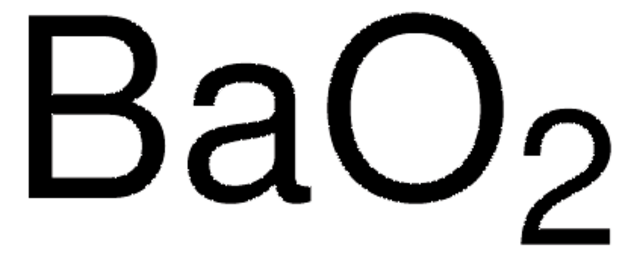추천 제품
일반 설명
Barium oxide, also known as barium(II) oxide, is a white or off-white fine powder with a melting point exceeding 1,800 °C. It is a highly stable compound with a high melting point and good chemical resistance, making it suitable for use in a wide range of applications. There are several methods to produce barium oxide including the thermal decomposition of barium carbonate and the electrolysis of barium chloride.
애플리케이션
Barium oxide is used in a variety of applications. It is used as a raw material in the production of ceramics, such as glazes and ceramic pigments. It is used as a refractory material in the production of furnace linings and high-temperature applications. It is used as a fluxing agent in the production of glass, helping to lower the melting point and improve the clarity of glass. It is used as a catalyst in the production of polyethylene and other polymers. It is often used as a starting material to produce other barium compounds or dope semiconductors.
특징 및 장점
Used in the synthesis of the high-κ material BST (barium strontium titanate). Used in the study of NOX storage.
신호어
Danger
유해 및 위험 성명서
Hazard Classifications
Acute Tox. 3 Oral - Acute Tox. 4 Inhalation - Eye Dam. 1 - Skin Corr. 1B
Storage Class Code
6.1D - Non-combustible acute toxic Cat.3 / toxic hazardous materials or hazardous materials causing chronic effects
WGK
WGK 1
Flash Point (°F)
Not applicable
Flash Point (°C)
Not applicable
개인 보호 장비
Eyeshields, Faceshields, Gloves, type P3 (EN 143) respirator cartridges
이미 열람한 고객
Sonia Kudłacik-Kramarczyk et al.
Materials (Basel, Switzerland), 13(15) (2020-07-29)
Barium titanate is a ferroelectric perovskite with unique electric properties; therefore, it is widely applied in the fabrication of inorganic coatings or thin films, capacitors, or in the production of devices for energy storage and conversion. This paper describes the
Lei Yang et al.
Nature communications, 2, 357-357 (2011-06-23)
The existing Ni-yttria-stabilized zirconia anodes in solid oxide fuel cells (SOFCs) perform poorly in carbon-containing fuels because of coking and deactivation at desired operating temperatures. Here we report a new anode with nanostructured barium oxide/nickel (BaO/Ni) interfaces for low-cost SOFCs
Paolo Raiteri et al.
Journal of physics. Condensed matter : an Institute of Physics journal, 23(33), 334213-334213 (2011-08-05)
A new reactive force field to describe proton diffusion within the solid oxide fuel cell material BaZrO(3) has been derived. Using a quantum mechanical potential energy surface, the parameters of an interatomic potential model to describe hydroxyl groups within both
Garima Tripathi et al.
Spectrochimica acta. Part A, Molecular and biomolecular spectroscopy, 66(4-5), 1307-1311 (2006-08-22)
Radiative properties of Er3+-doped tertiary bismuth glass has been analyzed by the Judd-Ofelt theory. NIR to visible upconversion in the Er3+-doped glass has been reported. The mechanism for the upconversion is explained on the basis of quadratic dependence on excitation
Shunyi Li et al.
Journal of physics. Condensed matter : an Institute of Physics journal, 23(33), 334202-334202 (2011-08-05)
The electrical properties of (Ba, Sr)TiO(3) (BST) thin films are studied using different combinations of Pt and tin-doped indium oxide (In(2)O(3):Sn, ITO) as electrode material. With Pt as bottom and top electrode the films show insulating behaviour with a low
자사의 과학자팀은 생명 과학, 재료 과학, 화학 합성, 크로마토그래피, 분석 및 기타 많은 영역을 포함한 모든 과학 분야에 경험이 있습니다..
고객지원팀으로 연락바랍니다.














